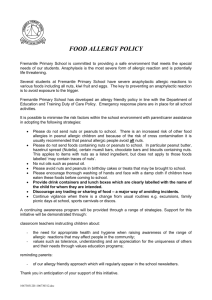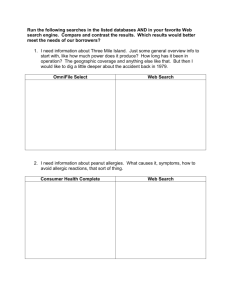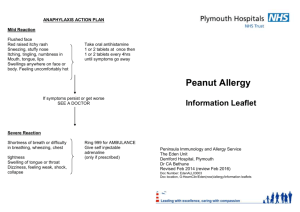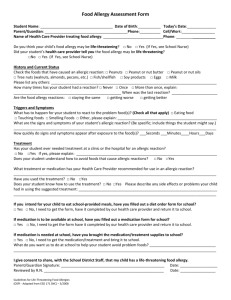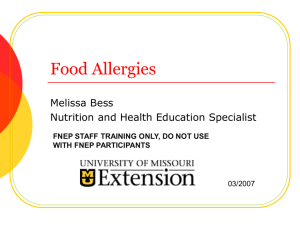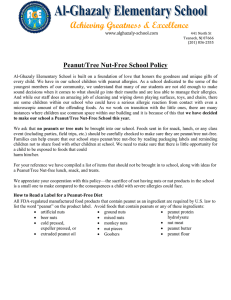MICHAEL KEATING, M
advertisement
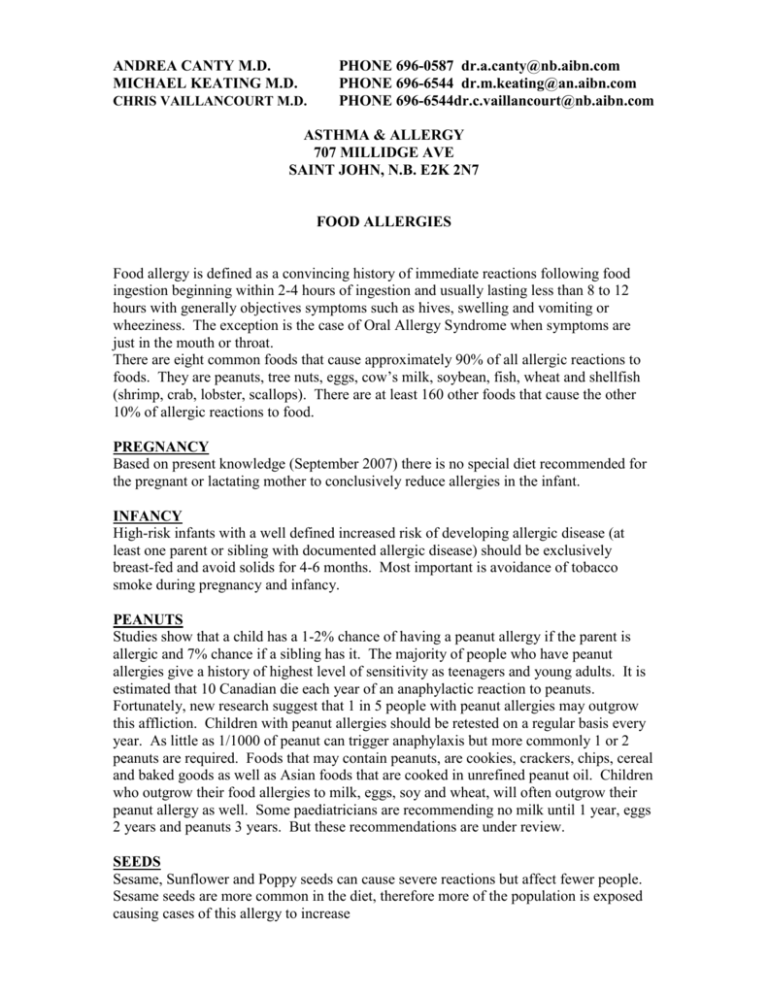
ANDREA CANTY M.D. MICHAEL KEATING M.D. CHRIS VAILLANCOURT M.D. PHONE 696-0587 dr.a.canty@nb.aibn.com PHONE 696-6544 dr.m.keating@an.aibn.com PHONE 696-6544dr.c.vaillancourt@nb.aibn.com ASTHMA & ALLERGY 707 MILLIDGE AVE SAINT JOHN, N.B. E2K 2N7 FOOD ALLERGIES Food allergy is defined as a convincing history of immediate reactions following food ingestion beginning within 2-4 hours of ingestion and usually lasting less than 8 to 12 hours with generally objectives symptoms such as hives, swelling and vomiting or wheeziness. The exception is the case of Oral Allergy Syndrome when symptoms are just in the mouth or throat. There are eight common foods that cause approximately 90% of all allergic reactions to foods. They are peanuts, tree nuts, eggs, cow’s milk, soybean, fish, wheat and shellfish (shrimp, crab, lobster, scallops). There are at least 160 other foods that cause the other 10% of allergic reactions to food. PREGNANCY Based on present knowledge (September 2007) there is no special diet recommended for the pregnant or lactating mother to conclusively reduce allergies in the infant. INFANCY High-risk infants with a well defined increased risk of developing allergic disease (at least one parent or sibling with documented allergic disease) should be exclusively breast-fed and avoid solids for 4-6 months. Most important is avoidance of tobacco smoke during pregnancy and infancy. PEANUTS Studies show that a child has a 1-2% chance of having a peanut allergy if the parent is allergic and 7% chance if a sibling has it. The majority of people who have peanut allergies give a history of highest level of sensitivity as teenagers and young adults. It is estimated that 10 Canadian die each year of an anaphylactic reaction to peanuts. Fortunately, new research suggest that 1 in 5 people with peanut allergies may outgrow this affliction. Children with peanut allergies should be retested on a regular basis every year. As little as 1/1000 of peanut can trigger anaphylaxis but more commonly 1 or 2 peanuts are required. Foods that may contain peanuts, are cookies, crackers, chips, cereal and baked goods as well as Asian foods that are cooked in unrefined peanut oil. Children who outgrow their food allergies to milk, eggs, soy and wheat, will often outgrow their peanut allergy as well. Some paediatricians are recommending no milk until 1 year, eggs 2 years and peanuts 3 years. But these recommendations are under review. SEEDS Sesame, Sunflower and Poppy seeds can cause severe reactions but affect fewer people. Sesame seeds are more common in the diet, therefore more of the population is exposed causing cases of this allergy to increase TREE NUTS The person is usually counselled to avoid all tree nuts: Almonds, Brazil Nuts, Cashew, Hickory Nuts, Chestnuts, Filberts, Hazel Nuts, Macadamia Nuts, Pecans, Pine Nuts, Pistachios and Walnuts. However, recent research suggests that cashews and pistachios are related; walnuts pecans and hazelnuts are related, so avoidance of all tree nuts may not be necessary. COW’S MILK This is the most common food allergy in children with a prevalence of 2.5%. Exclusive breast-feeding is (avoidance of solid foods and cow’s milk for 4-6 months) is highly recommended. Alternatively, soy formula may be tolerated but there is a high frequency of concurrent soy allergy, so be prepared to switch. You may need to switch to extensively hydrolyzed formula (Alimentum or Nutramigen) or, raely, amino acid formula (EleCare or Neocate). Some research shows that by one year of age, 50% of infants can tolerate cow’s milk. This increases to 75% by age 2 and 90% by age 3. Unfortunately, adverse reactions to other foods and/or inhalants may develop in 35-50% before puberty. March 08

